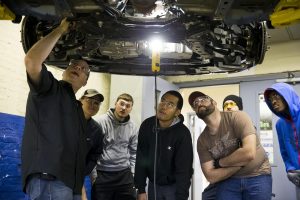Tesla Revolution is in the Factory, Not the Car
Critics say the Tesla Model 3 looks like a budget Mazda. That is fair. But they are missing the point. The project represents a revolution.
This week Electrek, a popular green energy publisher, reported that suppliers have begun ramping up deliveries to the factory where the Model 3 is produced. This is the same factory recently hit with hundreds of layoffs.
Tesla is now making cars, lots of cars. And doing so with fewer humans.
I have mostly stayed out of the Tesla debate. While the appeal of a no-compromises electric vehicle is high, it’s hard to get past the fact the company is burning through cash at a breakneck pace.
And Elon Musk, Tesla’s celebrity CEO, has not been able to deliver on production goals.
Again, the promise is great. The execution? Not so much.
Where Tesla shines is engineering. The company wants to completely rethink manufacturing. Musk envisions factories unencumbered by the physical limitations of humans. Think about that for a moment. His vision is not robots assisting humans. It’s complete replacement.
Musk calls this factory Alien Dreadnought. It is a revolution, with profound implications.
Related story:
Musk’s Next Space Shot: Factories Without Humans
Sociology aside, stripping humans from the process streamlines production. Costs would be slashed. And, most important, the pace would accelerate. Robots don’t require bathroom and lunch breaks. And they can be sped-up to rates that would be impossible for humans.
Transparency Market Research, a boutique research company, predicts the worldwide market for industrial automation will swell to $352.02 billion by 2024. This is no surprise. The accelerant is demand for operational efficiencies.
In fairness, Tesla-watchers have been down this road before …
With every shiny new model comes the promise of production efficiencies. The Model 3, with its simple design and negligible list of options, screamed efficiency. However, during the initial production run, bottlenecks slowed manufacturing to only 260 cars, in the entire quarter.

The bugs seem to be squashed. Hota Industrial, a maker of gears and axle assemblies, has been pushed into overtime. It’s trying to meet production targets of 5,000 units per week. The Taiwanese company has even resorted to airplanes, as opposed to boats, for shipping. The parts are in need right now.
The math is simple. Five thousand cars weekly is more than 250,000 annually, with fewer workers.
The advance of robotics is a function of this era. The exponential progression of information technology allows for better modeling and data analytics. It is easier to design efficient machines, then plug them into a thinking network. The combination is powerful.
Investors should not lose sight of this opportunity. There is no shortage of handwringing about the societal impact. I’m not going to lie; human casualties will be high. This is, after all, a revolution. However, many companies are already benefiting from this change.
One company makes design software. While design itself might seem like a logical candidate for disruption, this company anticipated the rise of artificial intelligence. Instead of fighting the trend, managers embraced it. They are adding AI to their platform, heading off competitors. And it is working. Sales are exploding as companies begin retooling for the future of automation.
Another firm makes electric motors and actuators. It is supplying the parts robotics companies need to build refrigerators, washing machines and consumer electronics. Another, Cognex Systems (CGNX), makes scanners and vision systems to help automotive robots see.
What all of these companies share, apart from a role in the robotics ecosystem, is strong management. Corporate executives were able to look into the future and see a niche. When that place was secured, they built considerable impediments to completion. And now they are thriving.
When Elon Musk announced dismal Model 3 production in October, and a series of layoffs at the company’s Freemont factory, it seemed as though the brave Tesla experiment was coming to an end. Based on new reporting, that pronouncement was premature.
Tesla is still a risky stock, for a variety of reasons. However, the promise of automation is a sure thing. Investors should be adding positions in automation enablers now.
Best wishes,
Jon Markman

